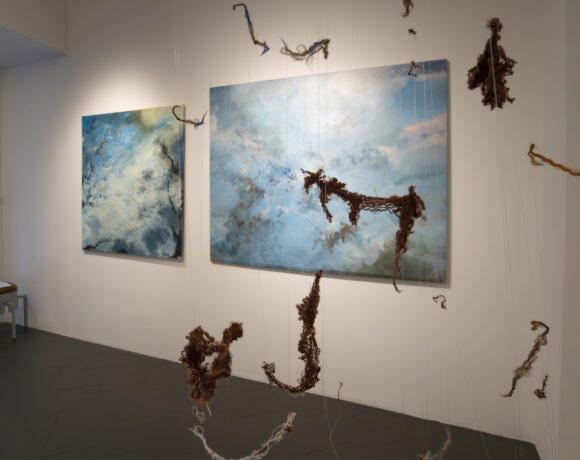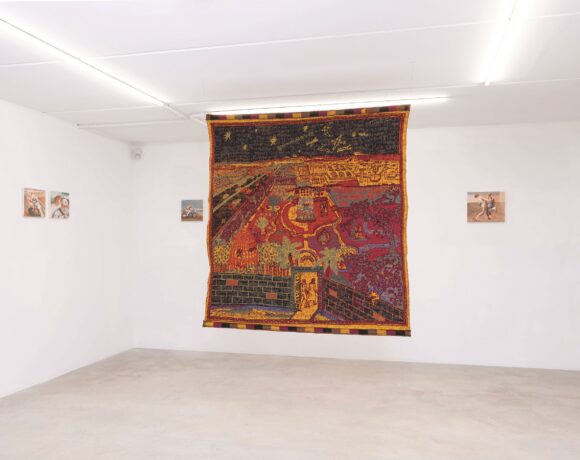There is still time until January 8, 2023 to visit the impressive monographic exhibition “Marlene Dumas. open-end”, dedicated to the artist Marlene Dumas (1953, Cape Town, South Africa) and curated by Caroline Bourgeois, at Palazzo Grassi in Venice. The exhibition brings together over 100 works, essentially paintings and drawings, obviously coming from the Pinault Collection, as well as from international museums and other private collections, exploring the artist’s practice and poetics from 1984 to the present, including new artworks, some of which were specifically conceived for the project.

Marlene Dumas, (from left to right) iPhone, 2018, courtesy David Zwirner, Alien, 2017, Pinault Collection, Spring, 2017, private collection, courtesy David Zwirner, Amazon, 2016, private collection, Switzerland. Installation view, Marlene Dumas. open-end at Palazzo Grassi, 2022. Ph. Marco Cappelletti con Filippo Rossi © Palazzo Grassi © Marlene Dumas
The exhibition itinerary inevitably incorporates the biography of Dumas, who was born in South Africa and moved to Europe in 1976, to Amsterdam, where she still lives and works: her art is imbued with a subtext and socio-political cues, which drawing on a deeply personal sphere, becomes a universal analysis, thanks to the use of a large archive of images from newspapers, magazines, film stills or personally taked polaroids, from which the artist draws inspiration. A continuous oscillation between micro and macro thematic approaches (as it is customary in humanity itself) characterizes a narrative that addresses existential milestones such as love and death, gender and racial issues, violence and tenderness, guilt, eroticism in all its meaning.

Marlene Dumas, (from left to right) Red Moon, 2007, De Ying Foundation, The Visitor, 1995, private collection. Installation view, Marlene Dumas. open-end at Palazzo Grassi, 2022. Ph. Marco Cappelletti con Filippo Rossi © Palazzo Grassi © Marlene Dumas
The title, choosen by the artist, brings a reflection concerning both the link between the works and that among the mood of their creator and the world around her. The short circuit between the terms “open” – which underlines Palazzo Grassi opening its doors to observe and experience the exhibition, after a period of forced closure due to the last pandemic years, as will also works of art, in which to immerse oneself in vast mazes of meanings to be interpreted and the word “end” bearer of a fluid and at the same time melancholy value, since where the work begins does not actually correspond to the point where it actually ends.

Marlene Dumas, (from left to right) Eye, 2018, private collection, iPhone, 2018, Courtesy David Zwirner, Alien, 2017, Pinault Collection. Installation view, Marlene Dumas. open-end at Palazzo Grassi, 2022. Ph. Marco Cappelletti con Filippo Rossi © Palazzo Grassi © Marlene Dumas
The multiplicity of plans and readings is pivotal in this extensive monograph, carried forward through the protagonism of the role of the written text, poetry and literature. This exhibition is thus characterized by a surprising gift offered by the artist, who takes yet another step in the name of the aforementioned openness, in this case showing a passage towards her casket of thoughts and annotations, which become part of the guide available to the visitor. A book to be kept as a precious tool for approaching the pictorial surface, with a completely freedom approach and whispered by Dumas with a discreet and noble confidence.

Marlene Dumas, (from left to right) Dora Maar (The Woman Who saw Picasso cry), 2008, private collection, courtesy Zeno X Gallery, Antwerp, Struck, 2017, ProWinko ProArt Collection, Missing Picasso, 2013, private collection, Madrid. Installation view, Marlene Dumas. open-end at Palazzo Grassi, 2022. Ph. Marco Cappelletti con Filippo Rossi © Palazzo Grassi © Marlene Dumas
The poetic rhythm is also declined in the display, which develops on both floors, with an alternation of different sensations, in a range of opposing exhibition levels as claustrophobic as agoraphobic, both in the size of the works and in the architecture, which strongly marks the restitution of these and their message. The sumptuousness and visual richness of the context of Palazzo Grassi accompany the visitor along the path with games of empty and full, vertical and rounded scans, entrance halls with rich decorations and frescoes together with immaculate spaces, as the dialectic knows how to accomplish in its leaps of languages and virtuosity.

Marlene Dumas, (from left to right) The Origin of Painting (The Double Room), 2018, Time and Chimera, 2020, The Making of, 2020, courtesy the artist and Zeno X Gallery, Antwerp. Installation view, Marlene Dumas. open-end at Palazzo Grassi, 2022. Ph. Marco Cappelletti con Filippo Rossi © Palazzo Grassi © Marlene Dumas
It is impossible not to dwell on the pictorial properties of Marlene Dumas’ art, perceiving how painting becomes a physical act of exploration of bodies and stories, made up of liquid brushstrokes that define the subject without preparatory drawings. Apparitions, ghosts, these appear to be Dumas’ figures, in an art conditioned by the diktat of photographic appropriation, of reproduction, which allows to portray without asking permission, given the massification of the source to which it refers, and allows the possibility to lose the need to be on the spot where the scene takes place. Detaching herself from the contextualization of the event, the artist focuses on the feelings of those who are the protagonists of an investigation into visual knowledge, which she has materially and metaphorically collected together over the years.

Marlene Dumas, (from left to right) Mamma Roma, 2012, Pinault Collection, Pasolini, 2012, Pasolini’s Mother, 2012, collection of the artist. Installation view, Marlene Dumas. open-end at Palazzo Grassi, 2022. Ph. Marco Cappelletti con Filippo Rossi © Palazzo Grassi © Marlene Dumas
“Marlene Dumas. open-end” is an exhibition whose artistic weight is expressed without the need for rhetoric, for the level of its protagonist, the collection it belongs to, the building that hosted it and supports an important program of appointments and contents, consecrating it as one of the must-see exhibitions in Venice, city marked by the records of the just closed Biennale. The publication of a trilingual catalog (Italian, English, French) co-edited by Marsilio Editori accompanies the project, as well as a free podcast in which the artist converses with eminent personalities of the international cultural scene.
Info:
“Marlene Dumas. open-end”
27/03/2022 – 08/01/2023
Palazzo Grassi
Campo San Samuele 3231, Venezia
www.palazzograssi.it

Graduated in Foreign languages, literatures and European artist cultures, she worked as a visitor assistant in some prestigious art museums and institutions in London, UK. Once back to Italy, Caterina obtained a Master degree in Contemporary Art Markets from NABA, Milan, while starting collaborations with contemporary art galleries with roles as gallery assistant and exhibitions coordinator. She writes for art magazines and has recently started to work as independent curator, after attending a course in curatorial practices at the School for Curatorial Studies, Venice.






NO COMMENT